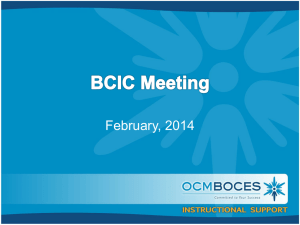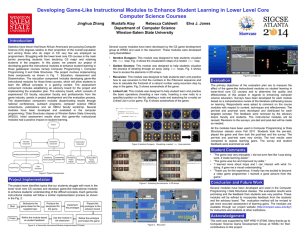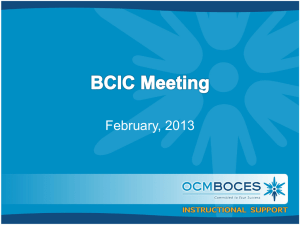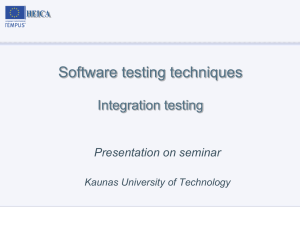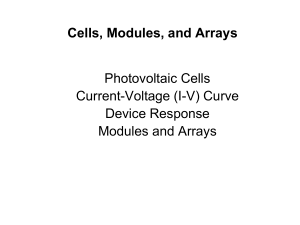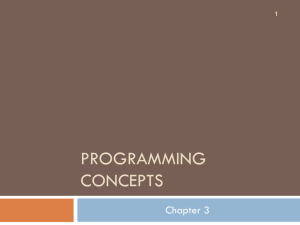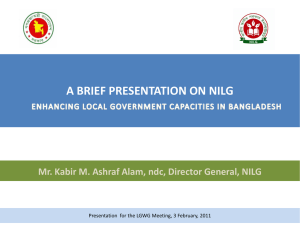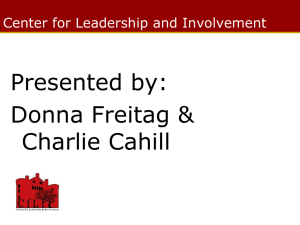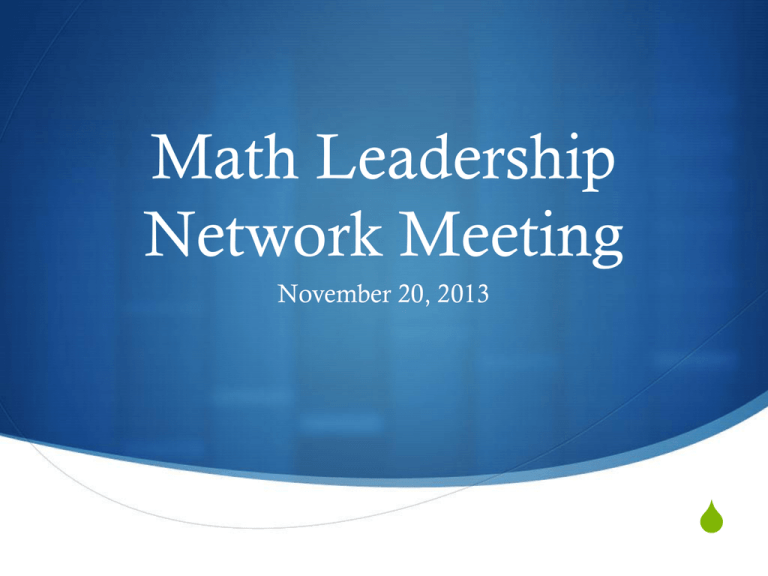
Math Leadership
Network Meeting
November 20, 2013
S
S January 17 5-8pm, Central Square Middle School
S January 18, 8am - 3:30pm, Central Square Middle School
S Break-out sessions by grade level led by Math Teacher Leaders.
The focus will be on understanding the complex math concepts
and instructional approaches of the grade level standards.
S $40 Charge per person
S Visit Sciencecenter.ocmboces.org to register
Agenda
S The Latest Communications from SED
S Implementation and Misconceptions of the Math Modules
S 7th & 8th Grade Accelerated Curriculum
S 3rd – 8th Grade Periodic Assessment Project
S OCM BOCES PD Opportunities
S Q&A
The Latest From SED
S PD Kits
S New Progression Documents
S Module Updates
S Statistics Module
S Teacher Flexibility
S Supporting Documents
S Overviews Units. Ratios, Functions
S Implementation Guide Units
S Checklist Units
S Closing the Gaps
S Assessment
Progressions
S K Counting and
Cardinality;
K – 5 Operations and
Algebraic Thinking
S K – 3 Categorical Data;
2 – 5 Measurement
Data
S K – 5 Number and
Operations in Base Ten
S K – 5 Geometric
Measurement
S K – 6 Geometry
S 3 – 5 Number and
Operations - Fractions
Progressions
S 6 – 7 Ratios and
Proportional Relationships
S 6 – 8 Statistics and
Probability
S 6 – 8 Expressions and
Equations
S 6 – 8 The Number System
S HS Algebra
S HS Statistics and
Probability
S Grade 8, HS Functions
S HS Modeling
PK – 5 Modules Update
Kindergarten
1st Grade
2nd Grade
3rd Grade
4th Grade
5th Grade
Modules 1,2,3,5
Modules 1-5
Modules 1-5
Modules 1-5
Modules 1-4
Modules 1-4
EngageNY
6 – 12 Modules Update
• Grade 6 Modules 1 - 3
• Grade 7 Modules 1 - 3
• Grade 8 Modules 1 – 4
• Algebra Modules 1 - 5
• Geometry Module 1
NYS COMMON CORE MATHEMATICS CURRICULUM
A Story of Functions
Developing Statistical Thinking Across the Grades
9
© 2012 Common Core, Inc. All rights reserved. commoncore.org
NYS COMMON CORE MATHEMATICS CURRICULUM
A Story of Functions
Developing Statistical Thinking Across the Grades
10
© 2012 Common Core, Inc. All rights reserved. commoncore.org
Curriculum Overviews
S Provides a picture of the modules at each grade level
S Year-long Summary
S Module Sequence Rationale
S Major Emphasis Clusters
S Alignment Chart with Time Line and Standards
Implementation Guide
S Information for implementing modules in classrooms
S Standards for Mathematical Practice
S Assessment Approaches
S Differentiation Strategies for ELLs, SWDs, Above
Level and Below Level Learners
S Mathematical Models
CCLS Checklist
Cross-reference of when each standard is addressed
Major emphases standards are marked with an asterisk
Post State Assessment are marked with a “+” sign
If you are adapting or referring to the modules you
could use this document to determine which module
addresses a particular standard
Implementing The Modules
S Logistical Issues: Pacing, Scripts, Answer Keys
S Instructional Issues: Gaps, Models and Strategies
S Mastery vs. Student Success
S Teacher Flexibility and Interpretation
S Fidelity
S Student Reactions
S Parent Comfort and Support
A Word from the
Commissioner
Guidance on Integrating
Curricular Materials into the
Classroom
S
The optional curricular materials on
EngageNY are designed to be adopted or
adapted. Educators will find both PDF and
Word versions available for their use. Some
lessons provide detailed instructions or
recommendations but it is important to note
that the lessons are not scripts and rather they
should be viewed as vignettes so that the
reader can imagine how the class could look.
Lessons are adaptable and allow for teacher
preference and flexibility so that what is
happening in the classroom can both meet
students' needs and be in service to the shifts
and the standards. If you do choose to make
significant changes to lessons, the
Tristate/EQuIP rubric is available to help you
evaluate the quality, rigor, and alignment of
your adapted lessons.
Also, please note that the Math modules include
a significant number of problem sets so that
students have ample opportunity to practice and
apply their knowledge. Educators can help
students to achieve deep conceptual knowledge
by asking them to complete selected problems
that have been designed in a sequential,
thoughtful order. It is not expected that all the
problems in a problem set be administered, but
rather educators can choose from the ample
amount of problems provided. Educators may
certainly adapt this curriculum using their own
judgment regarding student needs and pace of the
semester and/or year.
Instructional Models and Strategies
10 Frames
Addition Recording
5 Groups
Multiplication Recording
Base 10 Blocks
Arrays
Number Towers/Bundles
Area Model
Quick 10
Number Bonds
Place Value Disks
White Boards
Place Value Charts
Rekenrek
Instructional Models and Strategies
Tape Diagram
Integer Game
Vertical Number Line
Ratio Tables
Double Number Line
Coordinate Plane
Hide Zero Cards
Equations y=kx
Sprints
Fraction Tiles
Decomposing Numbers
Ratio Tables
Read-Draw-Write
Hundreds Chart
Number Bonds – A Foundation
The Tape Diagram
8
5
5
?
?
•
•
Part-whole models are usually more helpful when
modeling situations where you are given information
relative to a whole.
Compare to models are usually best when comparing
quantities.
22
8
Try this…
S 88 children were in swimming camp. One-third
of the boys and three-sevenths of the girls wore
goggles. If 34 students wore goggles, how many
girls wore goggles?
88
Children
at swim
camp
Boys
Girls
34
54
Did not
wear
goggles
Wore
goggles
Wore
goggles
20
34
14
Closing the Gaps
Foundational standards
Required fluencies from lower grades
Assessments from lower grades
Pre-Assessment
Differentiating and Scaffolding Instruction
Collaborating with your colleagues
Learn Zillion
http://learnzillion.com/
Remediating Prerequisite
Knowledge
S Assessing Conceptual
S
Conceptual Questioning, Discussion,
Models
S Remediating Conceptual
S
Use 15 minute sessions or whole class
sessions?
S
At beginning of year or all through
the year?
S Assessing Fluency
S
Rapid White-Board Exchanges
S Remediating Fluency Gaps
S
Sprints
Understanding
Understanding Gaps
Conceptual Understanding
S The 4 basic operations
S Properties of operations
S The equal sign; inequality
S Fractions
S Operations with negative numbers
S Exponentiation
S Systems of Equations
Remediating Strategy
S
Assess
S
Discuss and/or Model
S
Repeat
S
Use concrete objects – Starbursts
and Tape Diagrams
S
Subtraction- Use “fewer”
S
Multiplication means “equal
groups”. Use Array Model and
Area Model.
S
Division - Say “How many 5’s in
25?” Instead of “25 divided by 5.”
(½’s in 5? ½’s in 2/3?)
S
Rely on Properties to show math
Why is Negative x Negative a
Positive?
S
(-5)(-3) = ?
S
Why is the answer +15?
S
-5 (0) = 0
S
Multiplication by 0 = 0
S
-5 (-3+3) = 0
S
Additive Inverse (-3 + 3 = 0)
S
-5(-3) + -5(3) = 0
S
Distributive Property
S
-5(-3) + - 15 = 0
S
3 groups of -5 is equal to -15
S
-5(-3) has to be +15
S
Additive Inverse (+15 -15 = 0)
Why is Negative x Negative a
Positive?
S
The product is 2392.
(2000+300+80+12)
S
Draw the model with 60 and -8 (instead
of 50 and 2) x 40 and 6 since 60-8 is
equal to 52. Is the product the same?
(2400+360-320-48)
S
Draw the model with 60 and -8 x 50
and -4. The product has to be the same:
2392. In order for that to happen, the
product in the green portion of the
model has to be positive. (3000-240-400
+ (-4x-8) =2392. If not, the product
will not equal 2392.
Using a Tape Diagram to Show
Division of Fractions
Assessment Support and
Changes
S
Annotated Test Questions
S
Algebra Regents for 8th graders
instead of NYS Assessment
decision hopefully before
December break
S
Test Guides released before
December break
S
PARCC decision is coming
S
Only this year’s 9th graders have
option for both exams
S
Field-tested questions will remain
on Assessments
S
Cut score for passing will be
similar to past years
S
Calculator issues-email Steve Katz
th
7
and
th
8
Grade Acceleration
S What are districts doing to address
acceleration?
S How can we use the modules?
S 8th grade students taking Regents instead
of 8th Grade State Assessment
Assessment Project
S Multiple Choice and Extended Response Assessment
S Quarterly Administration
S Collaborative organized by BT BOCES
S 3 – 8 Assessments available to OCM BOCES Component
Districts (Math and ELA)
S Contact Catie Reeve (creeve@ocmboces.org)
Regional PD Opportunities
S
Digging into the Modules
S K – 5th Grade
S 6th – 8th Grade
S
Grade Level Networking
S K – 2nd Grade
S 3rd – 5th Grade
S 6th – 8th Grade
S Algebra
S Geometry
S
In-District Support
S
Topic Workshops
S Tape Diagrams
S Fractions
S Questioning
S Fluency
S Number Sense
Parent Connection
Resources on EngageNY http://www.engageny.org/
Videos on Learn Zillion http://learnzillion.com/
Singapore Strategies Packet
Math Journals
Parent Math Night
A Quick Read…
“Why the Common Core Changes
Math Instruction”
was published in a recent issue of
Kappan.
Add to Your Resource List
Kansas Association of Teachers of
http://katm.org/wp/common-core/
Math-Flipbooks
100 Math Smartboard Lessons K-5
http://www.squidoo.com/search/re
sults?q=100+math+smartboard+
lessons
Norma Boakes Instructional
Specialist Math Resources
https://delicious.com/nboakes
Common Core Resources
Illustrative Math
www.illustrativemathematics.org
PARCC
www.parcconline.org
Thinkfinity
www.thinkfinity.org
Achieve the Core
www.achievethecore.org
Inside Mathematics
www.insidemathematics.org
Erie 2 BOCES
http://e2math.weebly.com/index.html
On-Line Fluency Resources
S
Math Magician
S
Math Wire
S
Granny Prix
S
K-5 Math Teaching Resources
S
Fun for the Brain
S
Greg Tang Math
S
Math Apps
S
S
Ramos Group
Myers Corners Elementary
School
S
Math Dictionary
Model Drawing Resources
Thinking Blocks
www.thinkingblocks.com/
Step-by-Step Model
Drawing
by Char Forsten
Model Drawing for
Challenging Word
Problems
By Lorraine Walker
More Resources…
Jordan School District, Utah
(Math Practices Posters)
Granite Schools, Utah
(Vocabulary Cards)
K-5 Math Teaching
Resources (vocabulary & word
walls)
http://elemmath.jordandistrict.org/mathematicalpractices-by-standard/
http://www.graniteschools.org/depart/teachinglearni
ng/curriculuminstruction/math/Pages/Mathemati
csVocabulary.aspx
http://www.k-5mathteachingresources.com/
Mr. Wolfe’s Interactive
Whiteboard Practice
https://sites.google.com/a/norman.k12.ok.us/mrwolfe-s-math-interactive-whiteboard/
Discussion Groups
S
Topic?
S
Topic?
S
Topic?
S
Topic?
Questions???
Grades PreK - 8
Grades 6 - 12
Anne Marie Voutsinas
Jack McLoughlin
Network Team Member
Network Team Member
avoutsinas@ocmboces.org
jmcloughlin@ocmboces.org
Joanne Keim
Dana Corcoran
Network Team Member
Science Coordinator
jkeim@ocmboces.org
dcorcoran@ocmboces.org
THANK YOU!




